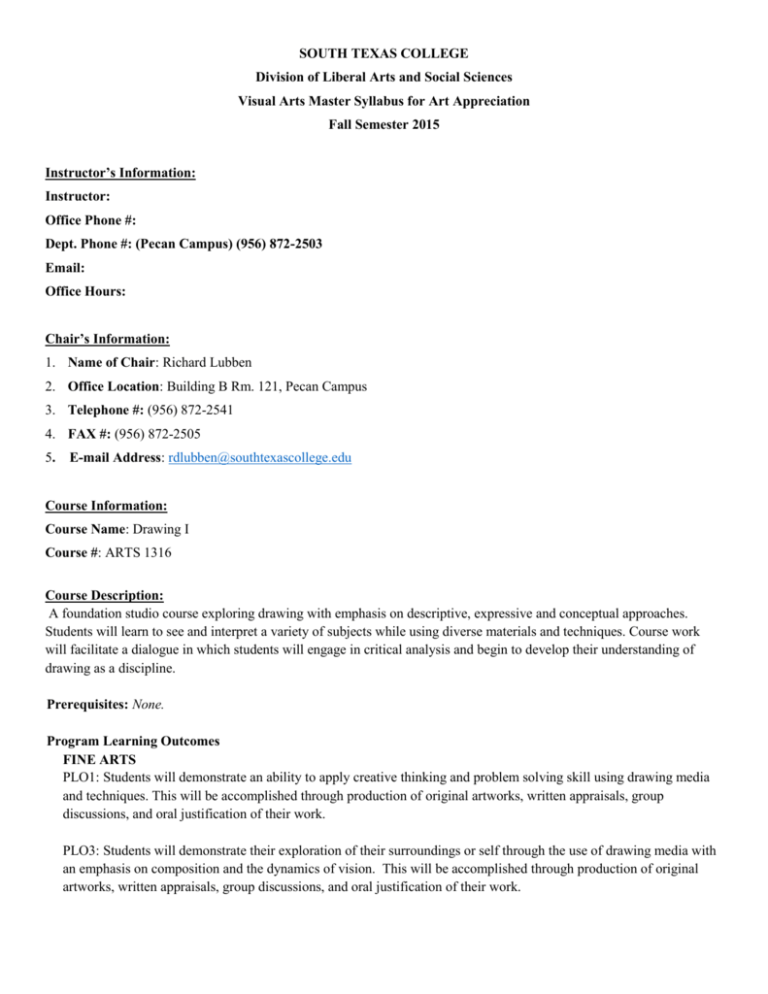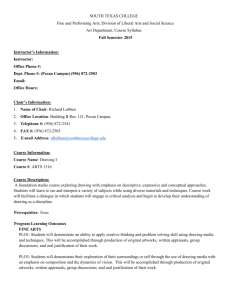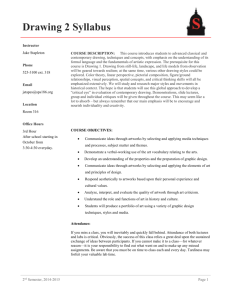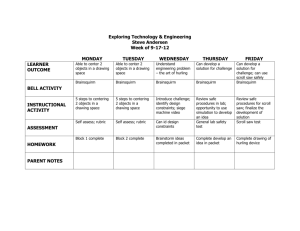ARTS1316 Master Syllabus Fall 2015
advertisement

SOUTH TEXAS COLLEGE Division of Liberal Arts and Social Sciences Visual Arts Master Syllabus for Art Appreciation Fall Semester 2015 Instructor’s Information: Instructor: Office Phone #: Dept. Phone #: (Pecan Campus) (956) 872-2503 Email: Office Hours: Chair’s Information: 1. Name of Chair: Richard Lubben 2. Office Location: Building B Rm. 121, Pecan Campus 3. Telephone #: (956) 872-2541 4. FAX #: (956) 872-2505 5. E-mail Address: rdlubben@southtexascollege.edu Course Information: Course Name: Drawing I Course #: ARTS 1316 Course Description: A foundation studio course exploring drawing with emphasis on descriptive, expressive and conceptual approaches. Students will learn to see and interpret a variety of subjects while using diverse materials and techniques. Course work will facilitate a dialogue in which students will engage in critical analysis and begin to develop their understanding of drawing as a discipline. Prerequisites: None. Program Learning Outcomes FINE ARTS PLO1: Students will demonstrate an ability to apply creative thinking and problem solving skill using drawing media and techniques. This will be accomplished through production of original artworks, written appraisals, group discussions, and oral justification of their work. PLO3: Students will demonstrate their exploration of their surroundings or self through the use of drawing media with an emphasis on composition and the dynamics of vision. This will be accomplished through production of original artworks, written appraisals, group discussions, and oral justification of their work. PLO4: Students will demonstrate their ability to develop a theme using drawing media as a means to personal expression. This will be accomplished through production of original artworks, written appraisals, group discussions, and oral justification of their work. PLO5: Students will demonstrate their ability to manipulate a particular medium creating a personal and original artwork. This will be accomplished through production of original artworks, written appraisals, group discussions, and oral justification of their work. GRAPHIC ARTS PLO1: Students will demonstrate the ability to communicate concepts and observations clearly and concisely through visual, verbal and written means. They will also solve given visual communication problems through research and information gathering, critical analysis, and the generation of original artwork. PLO2: Students will demonstrate their understanding of their surroundings or self through the use of both traditional and computer-based media. This will be accomplished through production of original artworks, written appraisals, group discussions, and oral justification of their work. PLO3: Students will demonstrate their ability to analyze design and communication challenges from multiple sources and diverse perspectives. Course Learning Outcomes At the conclusion of the course students will: 1. Describe visual subjects through the use of accurate and sensitive observation. (COM) 2. Generate drawings which demonstrate descriptive, expressive, and conceptual approaches. 3. Utilize varied materials and techniques with informed aesthetic and conceptual strategies. 4. Demonstrate an appropriate level of professional practice, including safety, craft and presentation. 5. Analyze and critique drawings verbally and/or in writing. (CT) 6. Relate drawing to design, art history and contemporary artistic production. 7. Demonstrate their ability to work effectively with others in teams toward a shared purpose or goal. (TW) 8. Demonstrate an understanding of the purposes and functions of art as it relates to social responsibility, cultural diversity and civic responsibility through written, oral, and hands-on art projects. (SR) Required Core Objectives for Core Component Area CRITICAL THINKING SKILLS: to include creative thinking, innovation, inquiry, and analysis, evaluation and synthesis of information. COMMUNICATION SKILLS: to include effective development, interpretation and expression of ideas through written, oral and visual communication. TEAMWORK: to include the ability to consider different points of view and to work effectively with others to support a shared purpose or goal. SOCIAL RESPONSIBILITY: to include intercultural competence, knowledge of civic responsibility, and the ability to engage effectively in regional, national, and global communities. Department Required Common Assignment to Meet and Assess Core Objectives This assignment will be given in all sections and will use the Institutional Core Objective Grading Rubric for assessment of the core objectives. Each of these four (4) components listed below will be evaluated via provided rubrics as 25% of the total grade for the assignment: 1. (COM) Students will effectively express ideas in a written, visual artwork, and oral form. 2. (TW) Students will work in teams to complete the assignment, and will evaluate one another’s participation and communication in the process. Additionally, students will evaluate other team’s completed artwork. 3. (SR) Possible topics for social responsibility messages include, but are not limited to: social awareness, identity, gender, political and social beliefs, censorship, environmental issues, human rights and ethics. 4. (CT) The assignment will demonstrate the development, interpretation, and expression of the chosen topic, thus showing the student’s ability to synthesize information and think critically. Addressing a Social Issue through Drawing: Students will divide students into groups of three, and will select an issue focusing on a social responsibility theme (e.g. the environment, human rights, social justice, civil rights, etc., etc.). Brainstorm on the topic - what is it about their chosen topic that resonates with them, what direction would they like to see it move, etc. Outside of class each student should research their topic and write a 2 page overview laying out the basics of the issue, what the average person should know but perhaps does not, and how society should address it. This could take the form of a position paper, or even a manifesto. Students should have at least three solid references (not Wikipedia), which should be listed MLA style. At the same time, students should gather images from magazines or printed out from websites that relate to their topic in some way. This could be literal (a photograph of someone’s civil rights being violated, for example) or symbolic (eyes filled with tears, flames, etc.). Each student should bring 5 to 10 images to class. In class the groups should reassemble, compare notes (but not copy one another’s papers, which will be turned in for an individual grade), and decide upon a strategy to address their group’s issue. What is it that they want to convey? On a 9” x 12” paper (OK to use your 18X24” paper and draw out the 9X12” dimensions) students are to arrange a collage made from pictures that they have taken, found online or in magazines. In addition to conveying a message (literal or symbolic or expressive) on the chosen social issue, the collage will focus on effectively using the elements and principles of art to obtain a well thought out composition. Students cannot use entire photos in the collage. The photos must be cut with scissors or an x-acto knife and glued to the base paper (9X12). If using a computer students can also crop them using any photo editing software. While the collage or photomontage is related to a social issue there should be no text in the final composition - the image, or accumulation of images and image fragments, should convey the message. Having collectively developed a composition, each student draw the collage on the 18” x 24” paper. Take care to accurately duplicate the collage in proportion. Students can make changes in values and shapes after starting the drawing if desired. Evaluation: Grading Criteria: A combination of oral assignments, written assignments, in-class or online quizzes/examinations, oral presentations, and classroom/online activities can be used to evaluate student performance. Each instructor will have at his/her discretion, the ability to combine the admixture to evaluate student performance. Students may display their level of understanding of the learning outcomes in several manners. The required department common assignment will be evaluated using the institutional core objective grading rubric. This course is designed to introduce a breadth of knowledge and reinforce cognitive, creative and problem solving skills. In addition to the evaluation of the artistic and creative aspects of work, no less than one-half of the student’s overall semester grade will be based on assignments and activities that focus on the appreciation and analysis of art including theory, criticism, aesthetics, design foundations, the interpretation of art and history. Required Textbook & Resources: Contact faculty teaching the course Classroom Expectation: 1. Demonstrate an understanding of the relationship of drawing to other disciplines and to society. 2. Demonstrate their informed comprehension of the formal aspects of a work. 3. Demonstrate the ability to develop and express ideas in written, oral, and/or hands-on art projects. 4. Demonstrate an understanding of the purposes and functions of art. 5. Identify artistic styles, periods and genres of art. 6. Demonstrate proficiency in traditional drawing techniques including gesture, contour line, expressive markmaking, cross-hatching, and stippling. 7. Demonstrate their ability to effectively produce and revise original drawings (primarily in graphite and charcoal), reports and critiques collaboratively and in teams. Safety Statement: Students entering studio/lab classes should be aware that they may be exposed to potentially hazardous chemicals and equipment. The students should assume responsibility for conducting themselves in a manner to minimize such hazards. (It is in the best interest of the students who are pregnant to defer laboratory/studio classes until after delivery.) Complete the safety instructions on the STC VAM website provided by the instructor. Students must read the VAM Health and Safety Manual at the following link: http://la.southtexascollege.edu/safety/ Download and print the CONSENT FORM from the appendices page. Sign the consent form and turn it in to your instructor. You must do so in order to attend class. STC Departmental Textbook and Supply Policy: All students must have the required materials including but not limited to textbooks, online access codes, equipment, and supplies no later than the second day of class. Students without required materials will not be able to participate in class activities and will therefore be counted as absent. Departmental Attendance Policy: (*applies to Traditional & Hybrid Classroom Courses) Attendance and participation are mandatory for all VAM courses. Students must attend a minimum of 39 of the scheduled 45 contact hours for lecture courses and a minimum 78 of the scheduled 90 contact hours for studio courses, regardless of personal or unforeseen circumstances that are beyond the student’s control. No absence will be regarded as either excused or unexcused. Students must be present for the entire duration of each class meeting. Students arriving 10 minutes late or leaving 10 minutes are encouraged to stay, but will be counted as absent, regardless of circumstances, for that day. FERPA: The Family Educational Rights and Privacy Act (FERPA) (20 U.S.C. § 1232g; 34 CFR Part 99) is a Federal law that protects the privacy of student education records. The law applies to all schools that receive funds under an applicable program of the U.S. Department of Education. FERPA gives parents certain rights with respect to their children's education records. These rights transfer to the student when he or she reaches the age of 18 or attends a school beyond the high school level. Students to whom the rights have transferred are "eligible students." Statement of Equal Opportunity: No person shall be excluded from participation in, denied the benefits of, or be subject to discrimination under any program or activity sponsored or conducted by South Texas College on the basis of race, color, national origin, religion, sex, age, veteran status or disability. Developmental Studies Policy Statement: The College’s Developmental Education Plan requires students who have not met the college-level placement standard on an approved assessment instrument in reading, writing, and/or mathematics to enroll in Developmental Studies courses including College Success. Failure to attend these required classes may result in the student's withdrawal from ALL college courses. Pregnant and Parenting Students South Texas College does not discriminate against any student on the basis of pregnancy, parenting or related conditions. Pregnant students seeking accommodations should contact the Title IX Coordinator and course instructor immediately. If you are absent or miss an assignment because of your pregnancy and wish to make-up the absence/assignment, you must provide a licensed medical doctor’s note stating what dates your physician advised you not to attend class or work. Only the absence(s) and work due during that period can be made up. Alternative Format Statement: This document is available in an alternative format upon request by calling (956) 872- 2503 ADA Statement: Individuals with disabilities requiring assistance or access to receive services should contact disABILITY Support Services at ( 956 ) 872-2173. Institutional Core Objective Grading Rubric The following matrix identifies the process for assessment of the required Core Objectives. Required Core Objectives Applied to Working in teams, students will demonstrate an understanding of the purposes and functions of art as it relates to cultural diversity and civic and social responsibility. Student groups will create a visual art project, research the topic and submit an essay that effectively communicates a given topic that deals with an aspect of the relationship of art and social responsibility. Assessment The rubric for this portion of the project and/or essay is designed to measure effective written and/or visual communication skills including the use of appropriate sources, documentation, and visual design elements. Passing Standard Approved passing standard on Institutional Rubric Target: Expected % of Students Meeting Core Objective 70% of all art projects and/or essays submitted will score 70% or higher. Critical Thinking Skills Communication Skills Teamwork Social Responsibility Study of and critical response to, through various means, to works in the arts and humanities. Departmental Common Assignment Student groups will create a visual art project and essay that effectively communicates a given topic that deals with an aspect of the relationship of art and social responsibility. Student groups will create a visual art project and essay that effectively communicates a given topic that deals with an aspect of the relationship of art and social responsibility. Student groups will complete a visual art project and presentation based on a given topic that deals with an aspect of the relationship of art and social responsibly. Each team member is responsible for researching and gathering material, analyzing material, and creatively contributing to the creation of the visual project. This activity encourages the ability to consider different points of view and to work effectively with others to support a shared purpose or goal. Student groups will create a visual art project and essay that effectively communicates a given topic that deals with an aspect of the relationship of art and social responsibility. The assignment will demonstrate the development, interpretation, and expression of the chosen topic, thus showing the student’s ability to synthesize information and think critically. Approved passing standard on Institutional Rubric 70% Students will effectively express ideas in a written, visual artwork, and oral form. Approved passing standard on Institutional Rubric 70% Students will work in teams to complete the assignment, and will evaluate one another’s participation and communication in the process. Additionally, students will evaluate other team’s completed artwork. Approved passing standard on Institutional Rubric 70% Possible topics for social responsibility messages include, but are not limited to: social awareness, identity, gender, political and social beliefs, censorship, environmental issues, human rights and ethics. Approved passing standard on Institutional Rubric 70%






